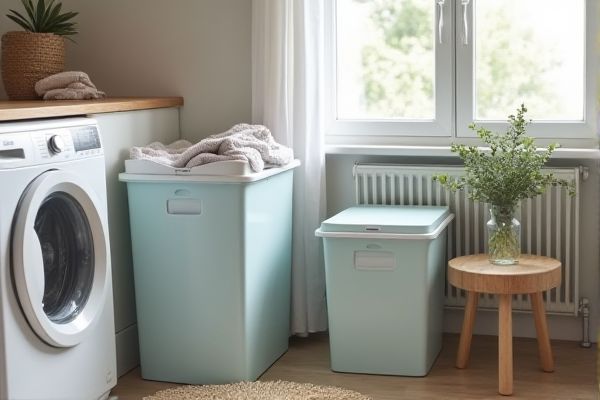
Textile bins offer breathable, flexible storage that helps prevent moisture buildup and odors in laundry, while plastic bins provide sturdier, waterproof protection ideal for stacking and long-term storage. Explore the rest of the article to discover which laundry storage option best suits Your needs.
Table of Comparison
| Feature | Textile Bin | Plastic Bin |
|---|---|---|
| Material | Fabric (Cotton, Polyester) | Durable Plastic (Polypropylene, Polyethylene) |
| Breathability | High - Prevents moisture buildup | Low - Traps moisture, risk of mildew |
| Weight | Lightweight and portable | Heavier, less portable |
| Durability | Moderate - Prone to tears | High - Resistant to impact and water |
| Cleaning | Machine washable or hand wash | Wipe clean with detergent |
| Collapsibility | Foldable for compact storage | Rigid, occupies fixed space |
| Cost | Generally affordable | Varies; often more expensive |
| Environmental Impact | Eco-friendly if natural fibers used | Less eco-friendly; plastic waste issues |
Introduction to Laundry Storage Solutions
Textile bins offer breathability and flexibility, making them ideal for storing damp or delicate laundry without trapping moisture. Plastic bins provide durability and protection from pests, ensuring your laundry stays clean and organized in any environment. Choosing the right storage depends on your specific laundry needs and space, helping you keep your clothes fresh and accessible.
Overview of Textile Bins
Textile bins for laundry storage offer breathable, lightweight, and flexible solutions that prevent moisture buildup and reduce odors compared to rigid plastic bins. Crafted from fabrics like cotton, canvas, or polyester, textile bins often feature handles for easy transport and foldable designs for convenient storage when not in use. Unlike plastic bins, textile bins promote airflow, helping to maintain cleaner and fresher laundry storage environments.
Overview of Plastic Bins
Plastic bins for laundry storage offer durability, moisture resistance, and easy cleaning, making them ideal for wet or damp environments. Their rigid structure provides better protection for clothes compared to textile bins, preventing deformation and pests. Available in various sizes and transparent options, plastic bins allow easy organization and quick content identification.
Durability: Textile vs Plastic Bins
Textile bins offer moderate durability with flexibility and breathability but are prone to wear and tear over time, especially with heavy loads. Plastic bins provide superior durability, resisting cracks, moisture, and stains, making them ideal for long-term, heavy-duty laundry storage. Choosing between textile and plastic bins depends on the need for durability versus lightweight and breathable storage solutions.
Aesthetic Appeal and Design Options
Textile bins offer a softer, more versatile aesthetic with a wide range of colors, patterns, and textures that seamlessly blend into home decor. Plastic bins emphasize durability and functionality with sleek, modern designs often available in transparent or solid colors, enhancing practicality. Choosing between textile and plastic laundry storage depends on whether style variety or structural robustness best fits the space and personal taste.
Ease of Cleaning and Maintenance
Textile bins are often machine washable and lightweight, allowing for easy cleaning and quick drying, which helps maintain hygiene in your laundry storage. Plastic bins, while generally wiped clean with a damp cloth, can accumulate grime in crevices and require more effort to sanitize thoroughly. Choosing the right bin depends on your preference for convenience in cleaning and the environment where the storage will be used.
Capacity and Space Utilization
Textile bins typically offer flexible capacity and can expand to accommodate irregularly shaped or bulky laundry items, maximizing space utilization in small or crowded areas. Plastic bins provide rigid structure, ensuring stable stacking and efficient use of vertical space, which is ideal for organized storage in closets or laundry rooms. Choosing the appropriate bin depends on balancing the need for adaptability versus structured storage to optimize overall laundry space.
Environmental Impact and Sustainability
Textile bins are often more sustainable than plastic bins because they are typically made from natural, biodegradable fibers or recycled materials, reducing landfill waste and lowering carbon footprints. Plastic bins contribute to environmental pollution due to their non-biodegradable nature and the energy-intensive production process involving fossil fuels. Choosing a textile bin for your laundry storage supports eco-friendly practices by promoting biodegradability and reducing reliance on single-use plastics.
Cost Comparison: Textile vs Plastic Bins
Textile bins generally offer a more affordable option for laundry storage, with prices often lower than durable plastic bins, especially when considering fabric materials like cotton or polyester. Plastic bins tend to be pricier due to their sturdiness, resistance to moisture, and longer lifespan, making them a cost-effective investment over time despite a higher upfront expense. Your choice depends on balancing initial cost savings with durability and functionality for efficient laundry organization.
Choosing the Right Laundry Bin for Your Needs
Textile bins offer breathability and flexibility, making them ideal for damp laundry and reducing odors. Plastic bins provide durability and moisture resistance, suitable for heavy loads or outdoor storage. Selecting the right laundry bin depends on your specific needs for ventilation, capacity, and durability to maintain hygiene and convenience.
 homyna.com
homyna.com